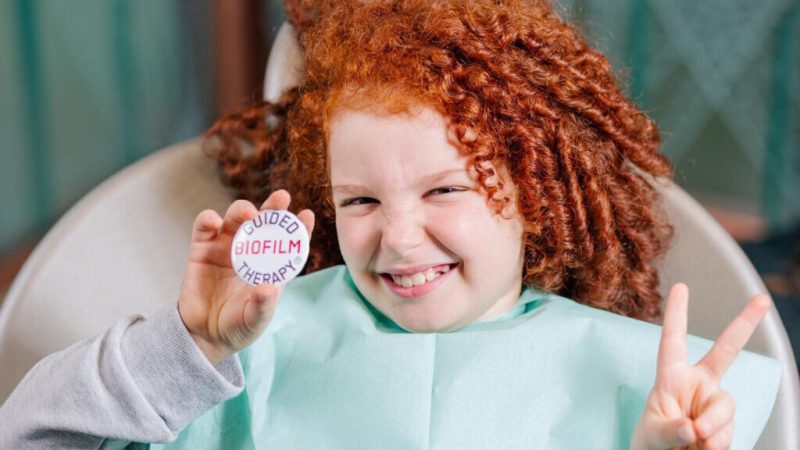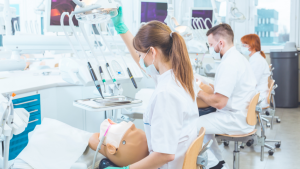The Guided Biofilm Therapy Is and Remains the Absolute Favourite

First published in ZMK, Jg. 39, Ausgabe 11-12, November/Dezember 2023.634-635, Spitta GmbH
Anyone who wants to stay healthy also values their oral health and regularly goes for professional prophylaxis. Following treatment with Guided Biofilm Therapy (GBT), over 278,000 patients worldwide were surveyed using standardized questionnaires. Of these, 94 percent prefer GBT to conventional methods and therefore recommend it to family and friends. They were also asked about their perception of pain, the time required and the usefulness of disclosing.
Due to the high burden of disease, the World Health Organization (WHO) has identified oral diseases – including caries and periodontitis – as a key health problem [1,2]. To get this under control, in addition to a healthy lifestyle, the microbial plaque (biofilm) must be removed regularly and completely. However, daily personal oral hygiene removes a maximum of 50% of the biofilm from supragingival tooth surfaces, particularly in the interdental area [3].
As a second pillar, regular and effective professional prophylaxis is therefore of crucial importance [4,5]. For this to be successful, it must be patient-friendly and reflect current knowledge and technical progress [6-11]. In response to these requirements, EMS developed the concept of Guided Biofilm Therapy (GBT) in collaboration with leading experts [12]. In order to determine the acceptance of GBT compared to conventional methods, patients of GBT-certified practices were surveyed using standardized questionnaires.
Method and Results
The certification protocol includes GBT training for the practice team by the Swiss Dental Academy (SDA) and the collection of patient feedback. The anonymized responses (n = 278,258) were provided to EMS by 13,082 GBT-certified practices and clinics for evaluation (as at 31.10.2023).
The questionnaire used for the feedback comprises 7 questions that can be rated on a scale of 0 to 5. All of them scored around 4.7 of 5.0 possible points, all showed a very high level of approval for GBT. Patients also rated the appropriate amount of time required and the absence of pain. With a proportion of 93.93%, they clearly preferred GBT to the conventional method (Fig. 1). 93.17% of respondents considered disclosing to be useful. This step in the GBT protocol ensures that the biofilm has been completely removed – a quality assurance for patient and practitioner. The University of Zurich was involved in the further development of the questionnaire.
Discussion
In conventional professional teeth cleaning, hard plaque is first removed using invasive sonic, ultrasonic and manual instruments [13]. Subsequent polishing also results in the loss of valuable tooth substance without achieving a smoother surface [14]. In addition, staining is often omitted [15]. In GBT, on the other hand, the biofilm as an etiological factor is first removed from all oral surfaces. This is done – after mandatory disclosing – in a minimally invasive and gentle manner with AIR-FLOWING®.


Highest effectiveness and efficiency is demonstrated by the AIRFLOW® Prophylaxis Master with the AIRFLOW® MAX thanks to the patented Laminar technology, PERIOFLOW® and PLUS Powder (Fig. 3) [17]. Only in the second step is the piezoceramic ultrasonic system (PIEZON® PS NO PAIN) used to remove the remaining visible calculus.
Today’s informed patients want effective and modern prophylaxis management in line with the state of the art in science and technology at eye level with the dental team. The absence of pain and the positive “experience” effect of gentle preventive treatment are also of great importance for patient loyalty during recall – and therefore also for the economic success of a practice. GBT has also been shown to be superior in these aspects, both in primary (PZR) and in secondary and tertiary prophylaxis (SPT) [6,7,9-11].
Conclusion
Accordingly, an updated evaluation of over 278,000 patient questionnaires clearly confirms the high patient acceptance of the GBT protocol. This was already found in an earlier evaluation from April 2022 (https://gbt-dental.com/ZMK-422-PS-NEW_ENG) [18]. The enthusiasm of the prophylaxis team for GBT could have a certain effect on the evaluation by patients (Hawthorne effect) [19]. However, the results of the patient survey are in very good agreement with published studies from practice and academia [20]. Due to the differentiated research question and high number of participants, a clear preference for GBT compared to conventional procedures can therefore be established.

The GBT-certified practice – here’s how it works
If you want to offer prophylaxis at the highest level, you can have your practice certified in accordance with GBT.
Further information can be found at https://gbt-dental.com/ZMK-11-12-patient-survey-sp or via the QR code

Literature
- Blas E, Kurup AS. Introduction and methods of work. In: World Health Organization: Equity, social determinants and public health programmes. In: World Health Organization (ed). Equity, social determinants and public health programmes, 2010:3-10.
- World Health Organization. Political declaration of the third high-level meeting of the General Assembly on the prevention and control of noncommunicable diseases. Report by the Director-General. EXECUTIVE BOARD EB150/7, 150th session 11 January 2022, Provisional agenda item 7. 2022.
- Sälzer S, Graetz C, Dörfer CE, et al. Contemporary practices for mechanical oral hygiene to prevent periodontal disease. Periodontology 2000. 2020;84(1):35-44. https://pubmed.ncbi.nlm.nih.gov/32844413/ https://onlinelibrary.wiley.com/doi/pdfdirect/10.1111/prd.12332
- Axelsson P, Nystrom B, Lindhe J. The long-term effect of a plaque control program on tooth mortality, caries and periodontal disease in adults. Results after 30 years of maintenance. J Clin Periodontol. 2004;31(9):749-57. Epub 2004/08/18. https://pubmed.ncbi.nlm.nih.gov/15312097/
- Tonetti MS, Chapple ILC, Jepsen S, et al. Primary and secondary prevention of periodontal and peri-implant diseases. Journal of Clinical Periodontology. 2015;42:S1-S4. https://pubmed.ncbi.nlm.nih.gov/25683242/
- Bastendorf K, Strafela-Bastendorf N. Auf das klinische Protokoll kommt es an – PZR, UPT und GBT. Quintessenz. 2020;71(12):1380-9.
- Vouros I, Antonoglou GN, Anoixiadou S, et al. A novel biofilm removal approach (Guided Biofilm Therapy) utilizing erythritol air-polishing and ultrasonic piezo instrumentation: A randomized controlled trial. Int J Dent Hyg. 2021;n/a(n/a). Epub 2021/07/05. https://www.ncbi.nlm.nih.gov/pubmed/34218516
- Bischoff JG. Herausforderung Prophylaxezentrum. Zahnarzt Wirtschaft Praxis. 2018(6):16-9.
- Bühler J, Amato M, Weiger R, et al. A systematic review on the patient perception of periodontal treatment using air polishing devices. Int J Dent Hyg. 2016;14(1):4-14. Epub 2015/01/27. https://www.ncbi.nlm.nih.gov/pubmed/25619863
- Bühler J, Amato M, Weiger R, et al. A systematic review on the effects of air polishing devices on oral tissues. Int J Dent Hyg. 2016;14(1):15-28. Epub 2015/02/19. https://www.ncbi.nlm.nih.gov/pubmed/25690301 https://onlinelibrary.wiley.com/doi/10.1111/idh.12120
- Fu JH, Wong LB, Tong HJ, et al. Conventional versus comprehensive dental prophylaxis: comparing the clinical outcomes between rubber cup and air polishing and the importance of plaque disclosure. Quintessence Int. 2021;0(0):0. Epub 2021/01/26. https://pubmed.ncbi.nlm.nih.gov/33491396/
- Lang N, A. L, KD. B. Scientific Consensus Guided Biofilm Therapy Protocol. A new concept to primary and secondary prevention. 2019. https://gbt-dental.com/ZMK1112-23-SP-ENG-Consensus
- Arefnia B, Koller M, Wimmer G, et al. In Vitro Study of Surface Changes Induced on Enamel and Cementum by Different Scaling and Polishing Techniques. Oral Health Prev Dent. 2021;19(1):85-92. Epub 2021/01/30. https://www.ncbi.nlm.nih.gov/pubmed/33511822
- Burkhardt AS, et al. Effect of air-polishing using erythritol on surface roughness of enamel and dentine compared to conventional methods. Poster presented at the EuroPerio, Copenhagen 2022. 2022.
- Stiftung Warentest. Weit aufmachen, bitte. Stiftung Warentest: Professionelle Zahnreinigung. test. 2015(7):86-90.
- Mensi M, Scotti E, Sordillo A, et al. Plaque disclosing agent as a guide for professional biofilm removal: A randomized controlled clinical trial. Int J Dent Hyg. 2020;18(3):285-94. Epub 2020/04/30. https://www.ncbi.nlm.nih.gov/pubmed/32348624
- Donnet M, Fournier M, Schmidlin PR, et al. A Novel Method to Measure the Powder Consumption of Dental Air-Polishing Devices. Applied Sciences. 2021;11(3):1101. https://www.mdpi.com/2076-3417/11/3/1101
- Koch JH. The „Guided Biofilm Therapy“ is the absolute favorite among patients. Worldwide survey on the preffered method of oral prevention. ZMK. 2022;38(4):183-5. https://gbt-dental.com/ZMK1112-23-SP-ENG-OralHealth
- Feil PH, Grauer JS, Gadbury-Amyot CC, et al. Intentional use of the Hawthorne effect to improve oral hygiene compliance in orthodontic patients. J Dent Educ. 2002;66(10):1129-35. https://www.ncbi.nlm.nih.gov/pubmed/12449206
- Furrer C, Battig R, Votta I, et al. Patient acceptance after switching to «Guided Biofilm Therapy». Swiss Dent J. 2021;131(3):229-34. https://pubmed.ncbi.nlm.nih.gov/33666383/, https://www.ems-dental.com/_flowpaper/php/ems.php?mid=7413&lang=en







